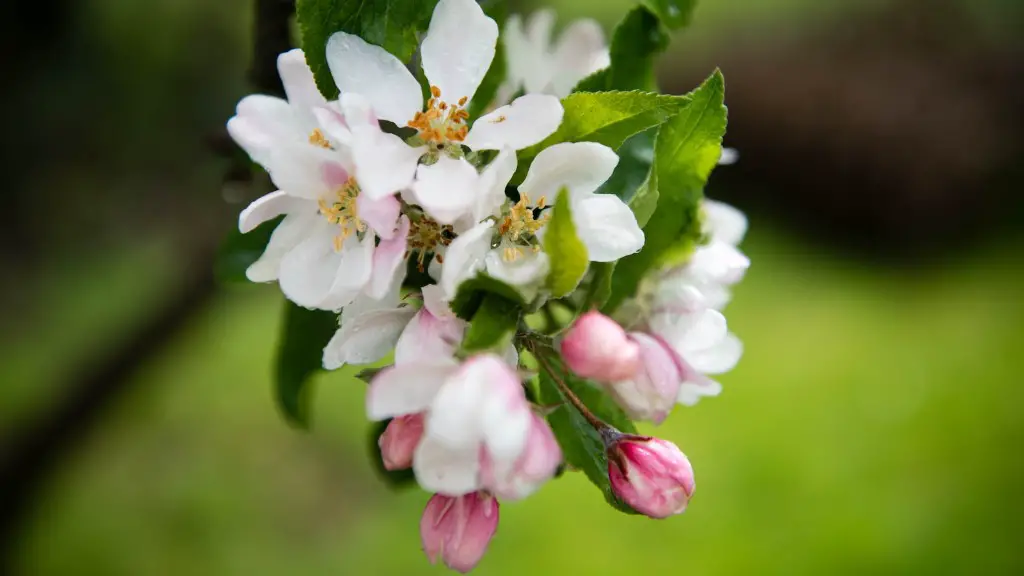Growing a lemon tree is a rewarding experience. Once mature, it produces lots of lemons that can be used for culinary purposes. In order to make a lemon tree flower, the gardener needs to understand the environmental conditions best suited for lemon tree flowers. Here are some tips to make a lemon tree flower.
First, the lemon tree should be located in a spot with ample sunlight, ideally 6-8 hours a day. To help ensure the flowers are healthy and able to produce fruit, the soil must be well-draining and rich in nutrients. Lemon growers should use fertilizers suited for lemon trees and avoid using too much nitrogen, which can prevent blooming.
Second, the lemon tree must be pruned to promote healthy growth. To promote a lot of flowers and plenty of lemons, the gardener should consider pruning the branches of the tree so it has an open structure allowing the light to reach the fruit and flower clusters. Pruning should generally be carried out in early spring.
Third, lemon trees prefer a warm temperate climate and do not do well in areas with cooler climates. During the winter, the gardener should make sure the lemon tree is protected from temperatures below freezing and maintain a temperature above 45 degrees Fahrenheit. To keep it healthy, it is important to keep the lemon tree hydrated and mulch around the base of the tree to keep moisture in.
Fourth, in order for the flowers to open and form fruit, it is important to ensure pollination happens. The gardener should consider hand pollinating, however it is also possible to use other means such as bees, who can easily pollinate many lemon trees. The gardener should ensure enough bees can get to the flowers without being disturbed, otherwise the pollination process will not occur.
Lastly, if the gardener does not see any flowers even after following the above precautions, it is possible the lemon tree is too young for flowers and needs to mature. If this is the case, patience is key and the gardener should pay attention to the lemon tree’s needs for a few more years until it is ready to flower.
Drought Conditions
One environmental condition that can prevent a lemon tree from flowering is drought. If the soil is dry, the tree may not produce fresh flowers. To overcome this, the gardener should consider irrigating to keep the soil and tree moist. If the lemon tree is growing in a pot, the gardener should water the tree two to three times a week. If the lemon tree is planted in the ground the gardener should check that the soil is moist before watering.
In addition, to prevent drainage of the soil and making it dry again, the gardener should cover the soil surface with a layer of mulch. This will help to retain water and keep the soil moist even during a dry spell. If the soil can be kept moist, the lemon tree should bloom.
In soils with poor drainage, the gardener should consider using raised planters instead of regular planters. This will help the lemon tree’s roots not to sit in water for long periods of time and get enough air.
If the gardener uses fertilizers, it should be done with caution. An excessive amount of nitrogen can interfere with the flowering process so care should be taken not to over-fertilize. Instead, the gardener should look for products specifically designed for flowering plants, such as high-phosphorus fertilizers.
It is also important to note that if the tree is not getting enough nutrients, no matter how well hydrated the soil and tree are, the flowers will not form. If this is the case, the gardener should measure the soil pH levels and add more organic material to the soil if it is too acidic.
Seasons
Typically, lemon trees flower in the spring. The gardener should check the flower buds that are growing on the tree and make sure the tree is surrounded with enough sunlight. This is because lemon trees need lots of sunlight in order to bloom healthily.
It is also important to note that excess cold or heat can prevent the lemon tree from blooming. If the gardener lives in an area with temperatures outside the range of 4-25 degrees Celsius, then the lemon tree will most likely not be able to bloom.
For frost-prone areas, the gardener should consider using a protective covering or container to shield the lemon tree from the cold winter air. If the tree is container-grown, it should be brought inside during the winter and replanted in the spring. This will ensure the lemon tree gets all the necessary sunlight and environment it needs while also avoiding extreme temperatures.
In addition, the gardener should be aware of the temperature during the growing season as well. Too much heat can cause the lemon tree to drop its flower buds, thus preventing it from blooming. To avoid this, the gardener should make sure the tree is surrounded by plants or other organic material that can keep it cool during the summer days.
In areas with distinct seasons, the gardener should also make sure the tree has a period of dormancy before it blooms. To ensure a good flowering period, the gardener should place the lemon tree in the shade during the winter and stop pruning it during the months prior to flowering.
Pests and Diseases
Incorrect pest and disease control can prevent a lemon tree from flowering healthily. To make sure the tree is adequately protected, the gardener should inspect the tree regularly for any bugs or disease signs and treat it as soon as possible.
The gardener should also periodically check for pests and if any are found, the gardener should use pest control methods specific for lemon trees. If the infestation is severe, it is best to remove the tree before the pests spread to other plants. The gardener should avoid using chemical pesticides if possible as these can have an adverse effect on the tree and its flowers.
In addition to pests, diseases can also prevent a lemon tree from flowering. The gardener should monitor the tree for fungal diseases, such as black spot or powdery mildew, as these can spread quickly and prevent the tree from flowering. If a fungal disease is present, the gardener should treat it quickly with an appropriate fungicide.
Finally, if the lemon tree is showing signs of stress, it can also prevent it from flowering healthily. Common signs of stress include wilting leaves, poor growth, yellowing leaves. If this is the case, the gardener should inspect the roots of the tree to make sure there are no root rot or other issues. If any are found, the tree should be treated quickly.
Fertilizer and Water Requirements
Fertilizer and water are essential for a lemon tree to bloom and produce fruit. The gardener should pay close attention to the fertilizer and water requirements of the tree and make sure to provide the necessary nutrients and moisture for the tree.
Fertilizer specifically designed for citrus trees should be used and applied 1-2 times a year, usually during the early spring. The fertilizer should contain a high phosphorus-nitrogen ratio, as phosphorus supports flowering and nitrogen helps with the tree’s overall health. The gardener should make sure to follow the fertilizer instructions properly.
In terms of water, lemon trees need about 1-2 inches of water every week. The gardener should also avoid over-watering, as too much water can drown the tree’s roots and cause root rot. Additionally, to help retain moisture in the soil, the gardener should consider mulching the soil surface.
Finally, the gardener should also consider using a soil test to determine if there are any deficiencies or an overabundance of certain nutrients that can stop or delay the flowering process. The test results should be shared with an expert who can suggest modifications to the soil composition warm the tree blooms.
Temperature and Humidity
Temperature and humidity are another important factor in getting a lemon tree to flower healthily. The gardener should make sure the tree experiences a temperature range of 15-27 degrees Celsius and enough humidity of 55-75%. If the temperature or humidity drop outside the desired range, the flower buds may drop, thus preventing blooming.
To keep the needed temperature up, the gardener should avoid pruning the tree in the winter and stop fertilizing the tree during the cooler months. Additionally, the gardener should consider using a greenhouse to keep the temperature and humidity consistent, especially in areas prone to frosts or extreme temperatures.
In terms of humidity, if the gardener does not live in an area with naturally high humidity, the gardener should consider misting the tree with water to keep the air around it moist. This can be done daily or every couple of days to ensure the tree has the necessary humidity.
In summary, the gardener should be aware of the environmental conditions suitable for lemon trees in order to get a healthy lemon tree that flowers correctly. The gardener should also consider monitoring the temperature and humidity of the tree and making sure the tree has enough water and fertilizer. Additionally, regular pest and disease control is essential to make sure the tree is healthy and blooms correctly. With these tips, the gardener should be able to get a lemon tree to flower correctly.





